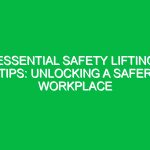Introduction
Good morning, team! Today, we are here for our Toolbox Talk, and I want to address an important topic that affects all of us: Back Injury Prevention. Back injuries are one of the most common workplace injuries and can have serious consequences not just for your health, but also for our overall productivity and workplace morale. It’s crucial that we all understand how to prevent these injuries, and I hope to provide you with practical tips and strategies that you can apply in your daily tasks.
Understanding Back Injuries
Before we dive into the Prevention strategies, let’s take a moment to understand what back injuries are and why they occur. Back injuries can range from sprains and strains to more serious conditions like herniated disks or chronic pain. These injuries often arise from:
- Improper lifting techniques
- Repetitive motions
- Prolonged sitting or standing
- Lack of ergonomic support
According to the Occupational Safety and Health Administration (OSHA), back injuries account for over 20% of all workplace injuries. This makes Back Injury Prevention not just a personal concern but a collective responsibility.
The Importance of Back Injury Prevention
Why should we prioritize Back Injury Prevention? Here are a few compelling reasons:
- Health Benefits: Preventing back injuries can save you from chronic pain and potential long-term disability.
- Increased Productivity: Healthy employees are more productive. Reducing the incidence of back injuries means fewer lost workdays.
- Reduced Costs: Fewer injuries lead to lower workers’ compensation costs and fewer medical expenses for both employees and the company.
- Improved Morale: A safe work Environment fosters a culture of care and respect, boosting overall morale.
Common Causes of Back Injuries in the Workplace
Identifying the common causes of back injuries is essential for prevention. Here are some factors we should be aware of:
- Improper Lifting: Lifting heavy objects without using the correct technique can strain your back.
- Poor Posture: Slouching while sitting or standing can lead to back pain.
- Inadequate Equipment: Using tools or workstations that are not ergonomically designed can cause stress on your back.
- Lack of Movement: Staying in one position for too long can lead to stiffness and discomfort.
Effective Strategies for Back Injury Prevention
Now that we understand the risks, let’s discuss some effective strategies for Back Injury Prevention:
1. Proper Lifting Techniques
One of the most critical aspects of Back Injury Prevention is learning how to lift correctly. Always remember the following steps:
- Stand close to the object you are lifting.
- Keep your feet shoulder-width apart for balance.
- Bend at your hips and knees, not your back.
- Use your legs to lift, keeping the object close to your body.
- Do not twist your body while lifting; instead, turn your whole body by moving your feet.
For example, if you are lifting a heavy box, approach it from the side, squat down, grip it securely, and lift using your legs. This technique not only reduces strain on your back but also utilizes your stronger muscle groups.
2. Ergonomic Workstations
Whether you are sitting at a desk or working on a production line, the ergonomics of your workstation play a significant role in preventing back injuries. Here are some tips:
- Adjust your chair so that your feet are flat on the floor, and your knees are at or below hip level.
- Use a chair with lumbar support to maintain the natural curve of your spine.
- Keep frequently used tools and materials within easy reach to avoid stretching or twisting.
- Take regular breaks to stand, stretch, and move around.
3. Stay Active
Regular physical activity strengthens your back and core muscles, which are essential for supporting your spine. Incorporate exercises that focus on:
- Strength Training: Focus on your core, back, and leg muscles.
- Flexibility: Stretching exercises can improve your range of motion and reduce tension.
- Cardiovascular Fitness: Activities like walking, swimming, or cycling can enhance overall fitness and endurance.
Consider starting your day with a few stretches or light exercises to prepare your body for the tasks ahead.
4. Use Assistive Devices
Whenever possible, use assistive devices to help with heavy lifting or repetitive tasks:
- Dollies and Hand Trucks: These can make transporting heavy items much easier.
- Forklifts or Hoists: For larger loads, utilizing machinery can significantly reduce the risk of injury.
- Ergonomic Tools: Tools designed to minimize strain can be beneficial for repetitive tasks.
Real-Life Scenarios
Let’s consider a couple of real-life scenarios to illustrate these strategies:
Scenario 1: Lifting a Heavy Box
Imagine you are tasked with moving boxes from one area to another. Instead of lifting with your back, you remember our discussion on proper lifting techniques. You squat down, grip the box securely, and lift with your legs. This simple choice helps you avoid a potential back strain.
Scenario 2: Long Hours at a Desk
Another example is working long hours at a desk. By adjusting your chair and taking regular breaks to stretch, you prevent stiffness and discomfort. This not only keeps your back healthy but also improves your focus and productivity throughout the day.
Open Discussion
Now, I would like to open the floor for discussion. What are some challenges you face regarding Back Injury Prevention? Are there any additional strategies that you have found effective? Your input is valuable, and together we can enhance our Safety practices.
Regulations and Compliance
It’s also important to understand that there are Regulations and Standards regarding Workplace Safety, including Back Injury Prevention. osha mandates that employers provide a safe work environment, which includes training and resources for proper lifting and ergonomic practices. Compliance with these regulations not only ensures your Safety but also protects the company from legal liabilities.
Conclusion
In summary, Back Injury Prevention is not just about protecting yourself; it’s about fostering a culture of safety within our workplace. By applying the techniques we discussed today—such as proper lifting, maintaining ergonomic workstations, staying active, and using assistive devices—you contribute to a safer environment for everyone.
Thank you for your attention and commitment to safety. Remember, a healthy back is crucial for your well-being, and together we can make our workplace injury-free. Let’s prioritize Back Injury Prevention in our daily operations and support one another in staying safe!


